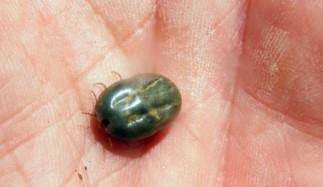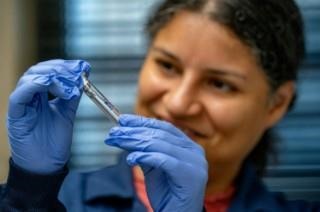Two projects by Texas A&M AgriLife Research scientists aim to protect the U.S. cattle industry from the emerging threat of pesticide-resistant cattle fever ticks.

Cattle fever tick populations with resistance to acaricides are a growing concern within the Texas cattle industry. (Texas A&M AgriLife photo)
Adela Chavez, Ph.D., AgriLife Research entomologist and assistant professor, and Patricia Pietrantonio, Ph.D., an AgriLife Research Fellow and professor, both in the Texas A&M College of Agriculture and Life Sciences Department of Entomology, each received a U.S. Department of Agriculture National Institute of Food and Agriculture grant directed at creating new ways to prevent tick infestations and protect Texas cattle from the diseases spread by cattle fever ticks.
Cattle fever ticks represent one of the greatest threats to the U.S. cattle industry. The ticks carry parasites and bacteria that cause deadly diseases, including bovine babesiosis and anaplasmosis. A few treatments but no effective vaccines exist for these diseases.
The Texas cattle industry urgently needs new technologies to combat these ticks, and the grant-funded research at AgriLife Research responds to the needs of the industry, said Phillip Kaufman, Ph.D., head of the Department of Entomology.
Pietrantonio received $625,000 for a three-year study to identify synthetic molecules that can be developed into treatments that kill cattle fever ticks but are nontoxic for livestock or humans. Chavez received $530,405 for a two-year study focused on creating vaccines for cattle.
“These studies have enormous implications not only for the cattle industry, but also for our overall biological understanding of ticks,” Kaufman said. “Novel research like this is challenging, but it is vitally important for the future of animal and human health.”
Cattle fever ticks threat reemerging
Ticks and tick-borne diseases significantly affect livestock globally. Tick feeding can reduce milk production and weight gain, damage hides, and cause anemia or even death.
Beef cattle and calf sales are Texas’ No. 1 agricultural commodity and generate about $8.5 billion annually. Worldwide, ticks cause an estimated $18.7 billion in economic losses each year.
Cattle fever tick eradication efforts began in 1906 and were officially eradicated in the U.S. in the early 1940s. But cattle fever ticks are still common in Mexico. They are an increasing threat to cattle producers because they are developing resistance to acaricides, the primary method to control them.
Ticks with resistance to permethrin, an acaricide not used against cattle fever tick in Texas but used widely in Mexico, has been found in Texas, despite tick quarantine efforts. However, the ticks have been shown to be resistant to many other acaricides outside the U.S., raising the threat to the cattle industry. Cattle fever ticks also infest wildlife, such as white-tailed deer and other exotic animals, including nilgai antelopes present in South Texas.
The movement of animals carrying ticks across the U.S.-Mexico border is a constant menace, as cattle ticks could become established and possibly transmit disease-causing pathogens to cattle herds. Tick resistance to acaricides makes it imperative to develop both anti-tick vaccines and new anti-tick treatments that are safe for vertebrate animals.
Vaccines to protect cattle

Adela Chavez, Ph.D., is expanding her tick research to seek a vaccine to treat cattle infected by cattle fever ticks. (Texas A&M AgriLife photo by Laura McKenzie)
Although some vaccines have shown partial protection, Chavez said genetic differences between tick populations reduce the vaccines’ efficiency. Her project will examine the potential use of substances from tick salivary glands and midguts as vaccine candidates.
Specifically, the study will focus on small particles, called extracellular vesicles, in the salivary glands and midguts of ticks. The team will examine the extracellular vesicles for proteins that cause immune responses in cattle and deer.
The team will conduct these studies on two very different tick species, the cattle fever tick and the lone star tick. Proteins that cause immune responses will then be used to generate artificial vesicles that can be mass-produced and commercialized to create a vaccine protective against different tick species.
Effective tick vaccines will decrease the impact of ticks and tick-borne disease on cattle, Chavez said. She added that the study could also provide information applicable to other delivery systems, potentially impacting both animal and human health.
“We’re creating something new,” Chavez said. “Everything we are doing is experimental – extracting the molecules, identifying the proteins in ticks to exploit, and creating artificial vesicles to then produce a vaccine to validate. It is exciting to think about the potential, but there is much work to be done.”
This project also involves Tammi Johnson, Ph.D., assistant professor of wildlife disease ecology in Texas A&M’s Department of Rangeland, Wildlife and Fisheries Management, and Don Thomas with the USDA-Agricultural Research Service.
Acaricides to disrupt ticks
As cattle fever ticks blood-feed on host animals, they transmit bacteria and parasites in their saliva. Pietrantonio said her project focuses on producing chemical molecules that selectively disrupt ticks’ ability to bite and feed.
This multidisciplinary project will evaluate small molecules discovered in Pietrantonio’s lab that act against a tick-specific protein and are not toxic to vertebrate cells. Researchers will also investigate tick physiology to identify tick hormone receptors that could be interfered with by small synthetic molecules that will be deadly, but only to ticks.
Pietrantonio’s team will screen thousands of synthetic molecules using state-of-the-art technologies to identify molecules that may be deadly to ticks. The project will produce new molecular knowledge of tick physiology and endocrinology with the goal of killing ticks or reducing the number of eggs the females produce, which in turn will decrease population size.
In addition to Pietrantonio, the project includes three USDA-Agricultural Research Service collaborators working on cattle ticks: Perot Saelao, Ph.D., Kevin Temeyer, Ph.D., and Don Thomas, Ph.D. The team also includes Dwight Baker, Ph.D., senior research scientist in the laboratory of James Sacchettini, Ph.D., in the Texas A&M Department of Biochemistry and Biophysics. The team members have complementary expertise in tick toxicology, physiology, genomics and chemistry.
“There is so much we do not know about ticks or their physiological and biological processes at the molecular level,” Pietrantonio said. “These are long-haul experiments to identify genes and receptors and critical tick processes we can disrupt and novel molecules that we can use safely.”
Source : tamu.edu